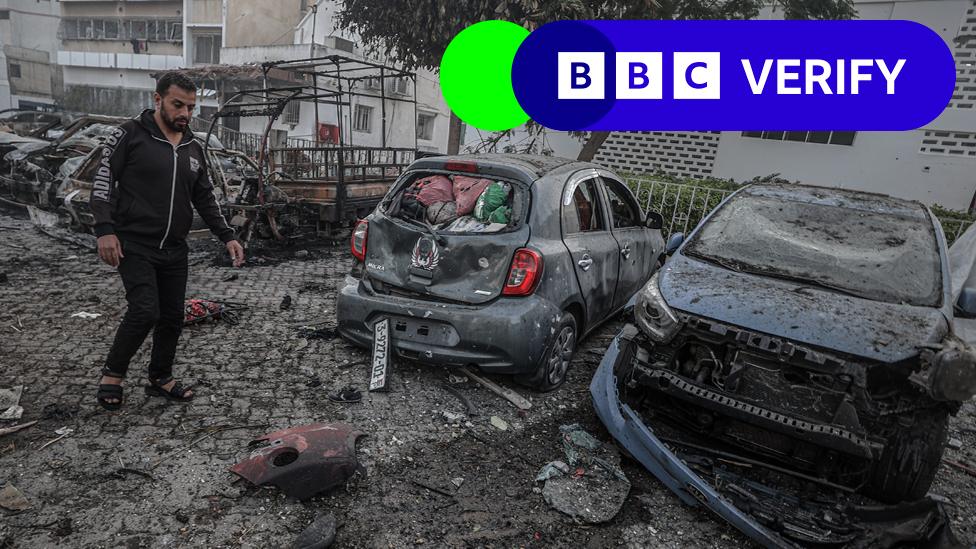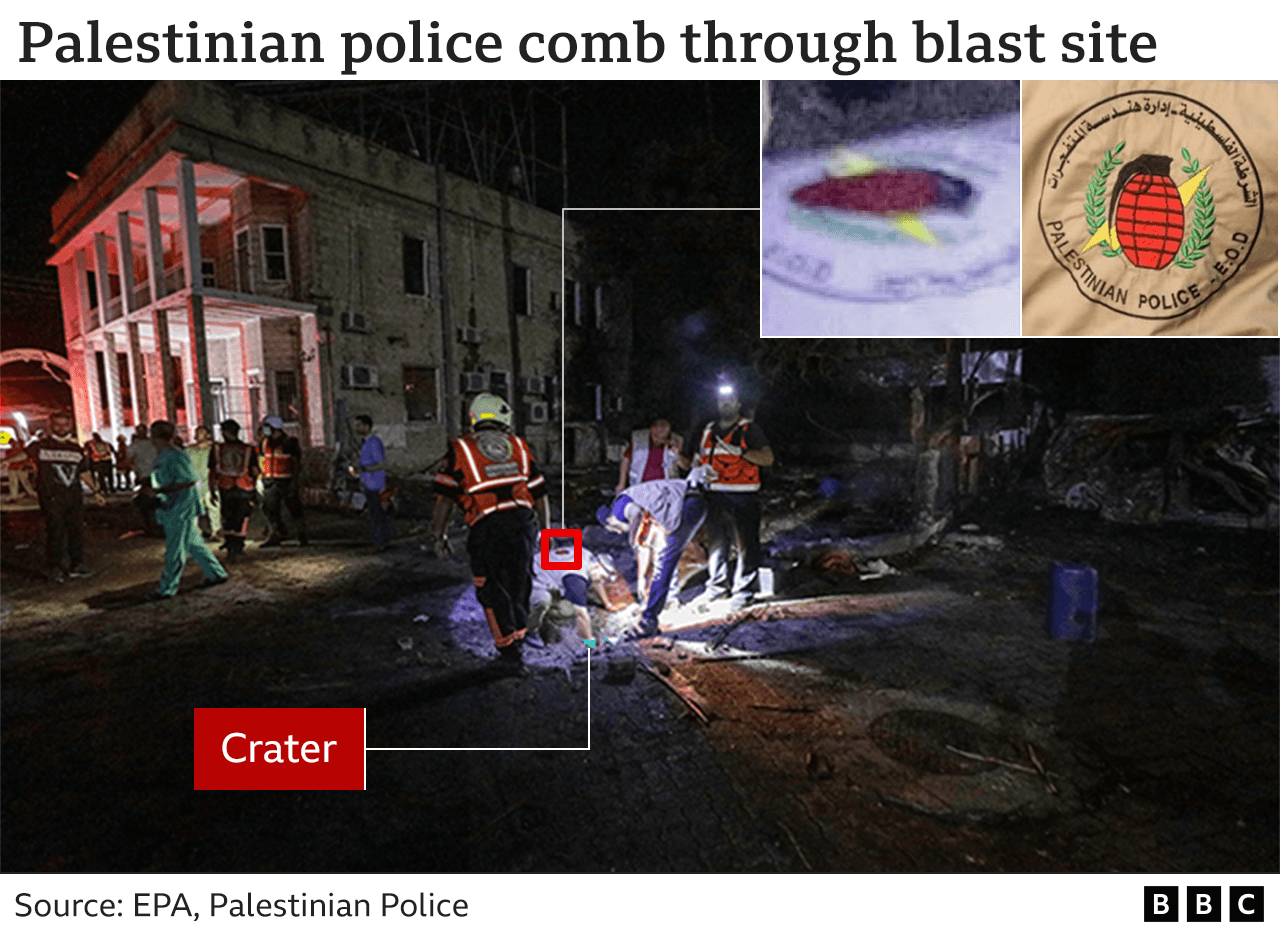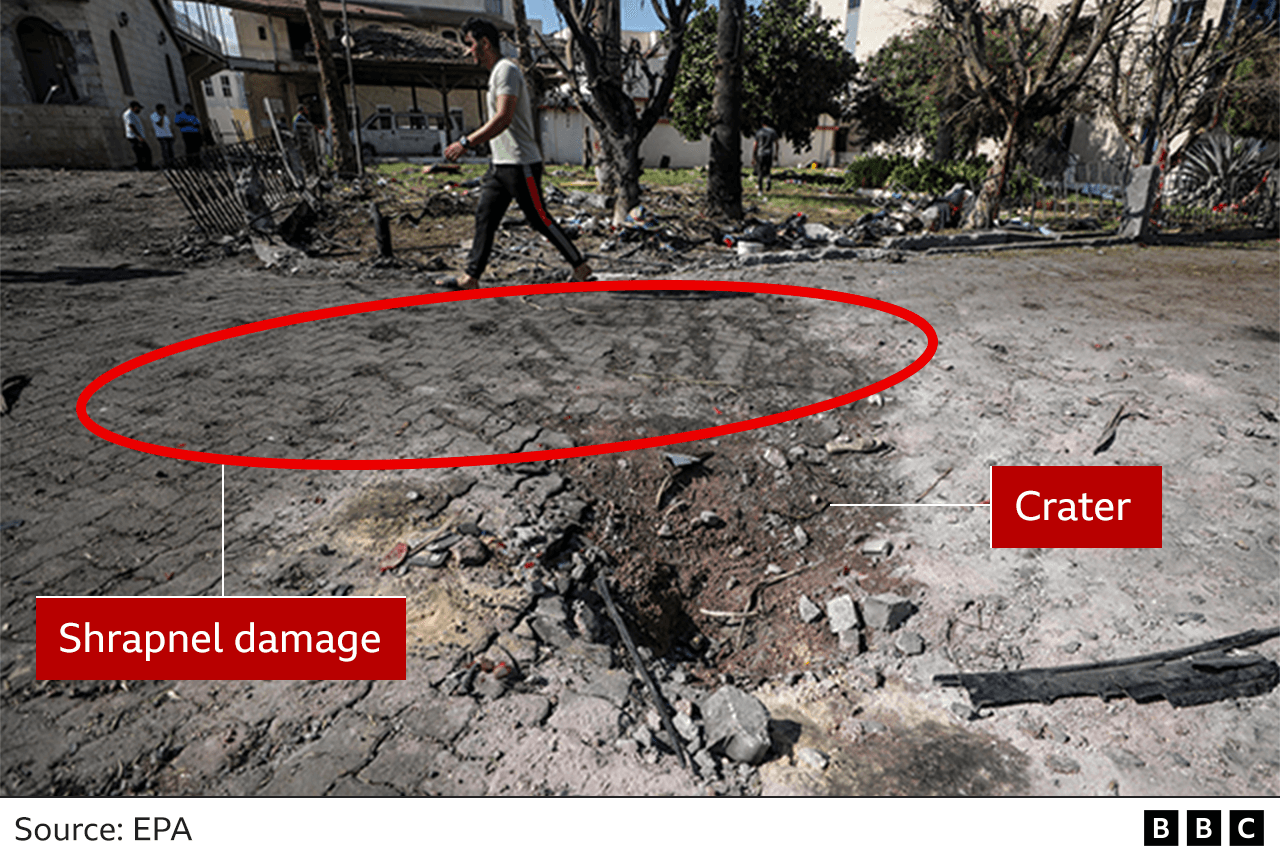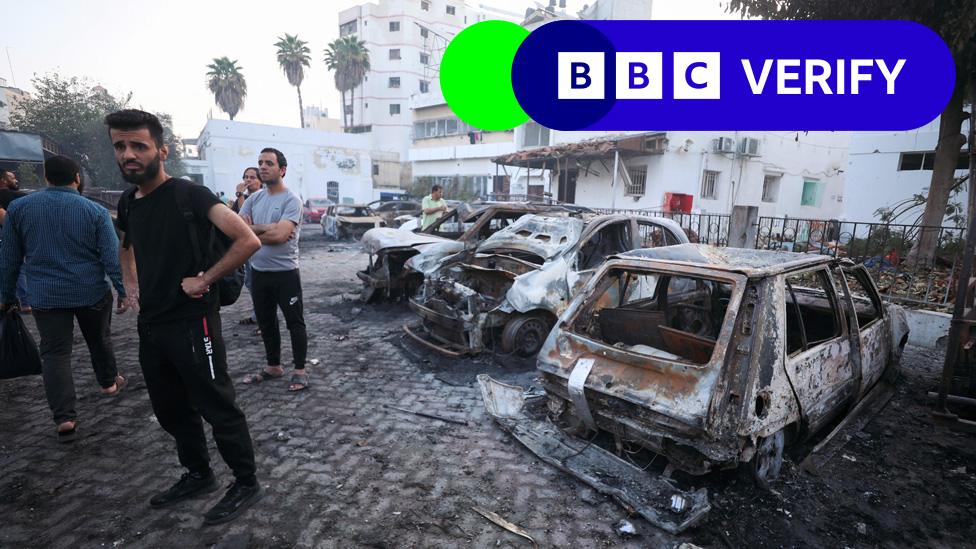Gaza hospital blast: What does new analysis tell us?
- Published

Nine days after the explosion at the car park of Al-Ahli Arab hospital in Gaza City, the exact cause of the blast is still contested.
The Hamas-controlled Palestinian authorities in Gaza accused Israel of hitting the hospital with an air strike. Israel said a misfiring rocket from the Palestinian Islamic Jihad (PIJ) group was to blame, which they deny.
The UK said on Monday its assessment, based on intelligence and analysis by weapons experts, was that it was likely a missile fired from within Gaza towards Israel was responsible. French military intelligence also came to this conclusion.
The US had already said Israel was not to blame based on "overhead imagery, intercepts and open-source information". The US - along with the UK and France - has not released the evidence that underpins their assessments.
Gaza's Hamas-run health ministry said almost 500 were killed. The Israeli military said the number was far lower.
Within 24 hours of the blast - which happened at 1900 local time on 17 October - the BBC Verify team had assessed video footage, pictures and other materials in an effort to understand what might have happened. A BBC journalist was also able to visit the site the day after the blast.
We have continued to look closely at the evidence and there has been further analysis from other media outlets as well as dozens of open-source intelligence experts on social media.
There are three areas which have been a focus since the blast: the lack of weapon fragments, the crater and damage at the scene, and video footage of a projectile rising over Gaza which was central to Israel's description of what happened.
Notable lack of weapon fragments so far
It is sometimes the case that what cannot be seen is as telling as what can be seen.
Usually one of the most important elements in investigating incidents of this kind is an on-the-ground investigation, including examining and recovering debris that might provide clues about the nature and origin of the weapon.
Pictures taken in the immediate aftermath show Hamas-led security forces on the scene, with officers wearing tops with logos of the Palestinian police's Explosive Ordnance Disposal Unit examining the crater.

But we have not seen any evidence of weapon fragments being recovered and there has been no significant update from officials in Gaza about their investigation.
Hamas told the New York Times that the missile had disintegrated beyond recognition. "The missile has dissolved like salt in the water. It's vaporised. Nothing is left," said Ghazi Hamad, a senior Hamas official.
Experts have said it is extremely unusual for a blast site such as this not to yield debris of this kind.
Former UN war crimes investigator Marc Garlasco tweeted, external: "In 20 years of investigating war crimes this is the first time I haven't seen any weapon remnants. And I've worked three wars in Gaza."
More theories on evidence from the scene
The most important evidence remains the state of the scene of the blast, which was clearly photographed by news agencies the morning after.
What was clear in the immediate aftermath of the blast was that it left only a small crater. Three experts told us the crater was much smaller than the damage usually caused by the sort of precision-guided munition often used by Israel.
These weapons are often used to flatten buildings or destroy underground structures like tunnels - and if one were to have dropped in the middle of the courtyard, several experts told us, it would have left a crater metres wide and deep.
Since then, some commentators have suggested that the lack of a large crater could be explained by the use of an "air burst" munition - a weapon set to explode above the ground. But the experts we spoke to said the blast scene was not consistent with this.
Those experts concurred that the pattern of damage on the ground meant the most likely cause was a rocket or a smaller munition.
The hospital's car park contained more than a dozen burned-out cars, including one that had been overturned.
There were damaged tiles, broken windows and shrapnel marks on surrounding hospital buildings but no visible structural damage.

J Andres Gannon, an assistant professor at Vanderbilt University in the US, said the heat generated from the impact may have been caused by leftover rocket fuel rather than an explosion from a warhead.
Justin Bronk, senior research fellow at the UK-based Royal United Services Institute (Rusi), agreed.
While it was difficult to be sure at such an early stage, he said, the evidence suggested the explosion was a result of a section of a failed rocket hitting the car park and its fuel and propellant (a combination of fuel and an oxidizer agent) causing a fire.
However in the past week, not every analysis has agreed with this.
The Forensic Architecture agency, a UK-based organisation which investigates human rights abuses, has carried out, external its own analysis of the crater, and suggests it is more consistent with the impact marks from an artillery shell which it concludes came from the direction of Israel.
It says that the scarring patterns above the crater are consistent with the shrapnel damage that would be expected from an artillery strike.
(On 14 November, Forensic Architecture removed a tweet and changed its analysis to say the projectile was probably a rocket although the group stood by its conclusion on the direction it had come from.)

Several types of artillery have been deployed by Israel since the start of the conflict, including M109 155mm howitzers, external and M270 MLRS rocket launchers, external.
We have since showed images of the crater to several weapons experts and asked them whether the damage markings were consistent with the type of explosion caused by artillery shelling.
NR Jenzen-Jones, a director at Armament Research Services, says the crater is significantly smaller than one typically generated by a 155mm artillery projectile.
But Mark Cancian of the Centre for Strategic and International Studies said that, based on evidence so far, it was difficult to differentiate whether it was caused by an artillery shell, a mortar or a rocket - it could potentially be any of them.
It's unlikely that evidence from the crater alone will help us understand exactly what caused this.
How significant is the projectile video?
Aside from images of the scene in the immediate aftermath, several video clips have emerged showing the explosion and the moments leading up to the blast.
We synced three video clips showing the moment of the explosion - one from the Al Jazeera news network, one from a CCTV camera, and another taken on a mobile phone near to the blast site.
BBC Verify has used CCTV time stamps and witness testimony to sync three videos
The Al Jazeera clip, shown in the bottom left above, has been pointed to by the Israeli authorities as evidence for their claim of a misfired rocket launched from within Gaza.
It shows an object moving through the sky, appearing to break apart, and then, a few seconds later, another explosion on the ground. We know this is the site of the hospital.
This clip has now been repeatedly analysed in an attempt to answer two key questions - what exactly was the projectile seen rising into the sky and could it have hit the hospital.
Open-source analysts including Oliver Alexander, external and Aric Toler and his team at the New York Times, external have cast doubt on whether the explosion in the sky shown in the Al Jazeera clip is related to the blast at the hospital.
Their analysis places the mid-air explosion some 3.2km (2 miles) away from the hospital, closer to the Gaza-Israel border.
In other words, they believe another projectile - not seen in the video - caused the deadly explosion, but they do not know what that was.

More on Israel-Gaza war
Follow live: Latest updates
Explained: What is happening in Israel and Gaza, and why now?
History behind the story: The Israel-Palestinian conflict
Bowen: Has the invasion begun?

It has also been disputed whether the mid-air explosion seen in that video is a malfunctioning rocket as Israeli authorities and others have said.
Some have suggested it shows a rocket being intercepted by the Israeli Iron Dome missile defence system.
However, several experts we spoke to said that the explosion in the sky isn't consistent with what is usually expected following an Iron Dome intercept.
"About one second before the explosion there appears a 'comet trail' of burning particles behind the rocket - probably pieces of disintegrating propellant grain. After the explosion there is an elongated glowing debris cloud that fades out after a couple of seconds. This is not typical to Tamir [Iron Dome] interception, where the Tamir's warhead explodes causing an almost immediate sympathetic explosion of the hostile rocket warhead," says Dr Uzi Rubin, an Israeli defence analyst at Rusi, who was the founder and first director of the Israel Missile Defense Organization.
We asked a number of other experts.
"The projectile does not have the flight path of Iron Dome. Additionally, Iron Dome almost never deploys just one interceptor," Mr Gannon says.
However, Mr Garlasco said he believed the footage was consistent with an Iron Dome interception.
The Israel Defense Forces (IDF) told the BBC that Iron Dome interceptions only happen over Israeli territory.
CCTV, amateur footage, and feeds from Al Jazeera and Israel's Channel 12 show that, in the minute before the hospital blast, there were at least two separate bursts of rockets in the area.
Analysts have emphasised that the most important thing in investigations like this is allowing independent investigators access to the site, to any physical evidence that has been collected and the ability to interview survivors.
That has not happened so far and is never easy in war zones.
Additional reporting by Tom Spencer, Benedict Garman, Paul Brown, Jemimah Herd, Tural Ahmedzade, Emma Pengelly, Alex Murray and Jamie Ryan.
Clarification, 10 January 2024: Some weeks after the attack, Forensic Architecture removed a tweet and said they had been wrong to say the projectile was an artillery shell, instead conceding it was probably a rocket. The organisation stood by its analysis of the direction it had travelled from.

Related topics
- Published19 October 2023

